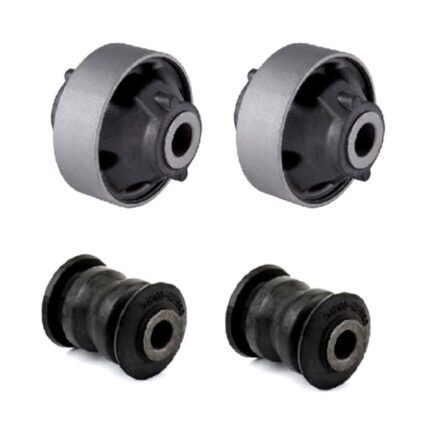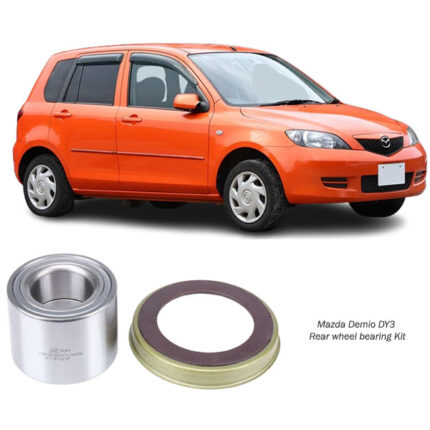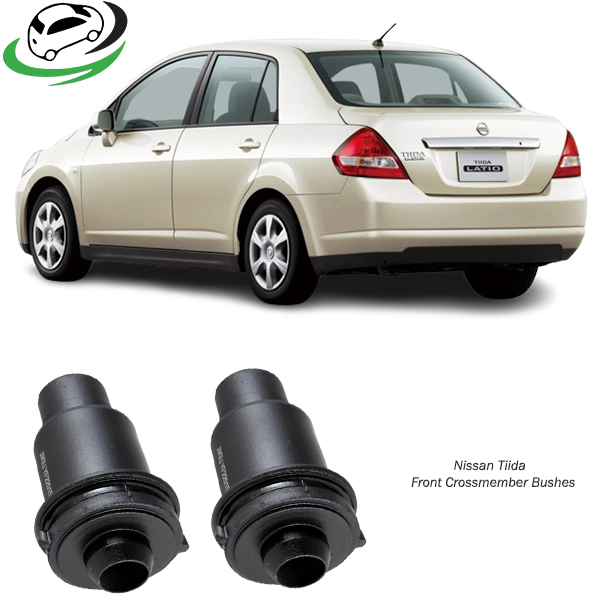-14%
Get Nissan Tiida Front Crossmember Bushes 54467-AX001 in Kenya
Front crossmember bushes, or front subframe bushes, are essential parts of a vehicle’s suspension system. They connect the crossmember to the vehicle’s chassis, playing a key role in stabilizing the front-end assembly, reducing vibrations, and absorbing shocks. These bushes impact not only the handling and comfort of the vehicle but also the durability of suspension components. In this article, we’ll discuss the purpose, construction, types, advantages, signs of wear, maintenance, and factors to consider when choosing front crossmember bushes.
1. Purpose of Front Crossmember Bushes
The front crossmember is a structural component that provides support to various parts, such as the engine and suspension system. The bushes that connect the crossmember to the chassis serve a few key purposes:
- Vibration Dampening: Front crossmember bushes absorb road vibrations, preventing them from transferring directly to the chassis. This enhances ride comfort by isolating the cabin from these vibrations.
- Shock Absorption: The bushes cushion shocks from road irregularities, which is vital for protecting suspension components and maintaining a smooth ride.
- Alignment Maintenance: The bushes help maintain alignment of the suspension and steering components, ensuring stability and control over the vehicle.
- Noise Reduction: By reducing metal-to-metal contact, the bushes help prevent clunking noises, particularly during turns or when driving over rough terrain.
- Load Distribution: The front crossmember bushes distribute the weight and forces exerted on the suspension, spreading them evenly across the structure.
2. Construction of Front Crossmember Bushes
Front crossmember bushes are generally composed of two main parts: a rubber or polyurethane core, and a metal sleeve. Their design allows flexibility while retaining strength, and they are often engineered with specific durometer ratings (a measure of hardness) to balance between flexibility and rigidity. Let’s break down the main components:
- Rubber Core: Traditionally, front crossmember bushes are made with a high-grade rubber core for flexibility. Rubber is ideal for absorbing shocks and isolating vibrations, making it an excellent material for most driving conditions.
- Polyurethane Core: Polyurethane bushes have gained popularity for their durability and performance. While slightly stiffer than rubber, polyurethane lasts longer and offers better performance under high-stress conditions.
- Metal Sleeve: A metal sleeve typically surrounds the rubber or polyurethane core, reinforcing the bush and allowing it to withstand the forces it encounters. This sleeve also ensures a tight fit between the crossmember and the chassis.
The construction of front crossmember bushes is crucial for balancing ride comfort and handling precision. Their design may vary depending on the vehicle type and its intended use.
3. Types of Front Crossmember Bushes
Front crossmember bushes are available in different materials and designs to suit various driving needs and conditions:
- Rubber Bushes: These are standard for most vehicles due to their comfort and affordability. Rubber bushes excel in vibration isolation and are softer than other options, offering a smoother ride.
- Polyurethane Bushes: Polyurethane is more durable than rubber, making these bushes suitable for performance vehicles or those frequently driven on rough terrain. They are stiffer than rubber, which translates to enhanced handling but slightly less comfort.
- Hydraulic Bushes: Hydraulic bushes contain a fluid-filled chamber within the rubber, providing superior damping characteristics. They are used in high-end and luxury vehicles for added comfort and vibration reduction.
- Solid Bushes: Made entirely of metal or hard materials, solid bushes are used in racing or off-road applications where stiffness and control are prioritized over comfort. They allow minimal movement but do not isolate vibrations as well.
4. Advantages of High-Quality Front Crossmember Bushes
Investing in high-quality crossmember bushes is essential for several reasons:
- Improved Vehicle Stability: High-quality bushes contribute to better vehicle stability, especially during cornering or when driving on uneven roads. This improves handling and control, enhancing safety.
- Enhanced Durability: Using durable materials like polyurethane or high-grade rubber extends the life of the bushes, reducing the frequency of replacements and overall maintenance costs.
- Reduced Wear on Suspension Components: Quality bushes absorb road impacts more effectively, minimizing stress on other suspension and steering parts, which prolongs their lifespan.
- Comfortable Ride: Quality bushes help isolate road vibrations, leading to a smoother and more comfortable ride for the driver and passengers.
- Noise Reduction: Bushes that effectively reduce metal-to-metal contact help prevent clunking or knocking sounds from the suspension system, contributing to a quieter cabin.
5. Signs of Worn or Damaged Front Crossmember Bushes
Recognizing the signs of worn crossmember bushes can prevent more significant suspension issues. Common indicators include:
- Vibrations in the Steering Wheel: Excessive steering wheel vibrations often point to worn or degraded crossmember bushes. This symptom may become more noticeable at high speeds.
- Clunking or Knocking Sounds: A clunking noise from the front of the vehicle during turns, acceleration, or braking can indicate damaged bushes, as they fail to cushion the movement.
- Poor Steering Control: Worn bushes cause misalignment in the suspension, leading to loose steering and making the vehicle harder to control.
- Uneven Tire Wear: A compromised suspension alignment caused by damaged bushes can result in uneven tire wear, affecting vehicle handling and requiring premature tire replacement.
- Increased Road Noise: Damaged or worn bushes lose their ability to absorb road noise, making the cabin noticeably louder while driving.
6. Maintenance of Front Crossmember Bushes
Regular inspection and maintenance of front crossmember bushes help maintain optimal vehicle performance. Here are some maintenance tips:
- Routine Inspections: Inspect the bushes regularly, especially if the vehicle frequently travels on rough roads or is used for heavy-duty applications. Look for cracks, tears, or other signs of wear.
- Lubrication: Some bushes, particularly polyurethane types, may require periodic lubrication to prevent squeaking and ensure smooth movement.
- Alignment Checks: Worn bushes can lead to misalignment in the suspension system. Periodic alignment checks and adjustments help maintain proper vehicle handling and prevent uneven tire wear.
- Timely Replacement: Replacing bushes as soon as wear signs appear helps avoid further damage to the suspension system and ensures a comfortable, stable ride.
- Use of Quality Parts: Opting for high-quality OEM or performance-grade aftermarket bushes is crucial to ensure durability and performance.
7. Replacement Considerations for Front Crossmember Bushes
When it’s time to replace the front crossmember bushes, several factors can guide the decision-making process:
- Driving Conditions: For drivers frequently on rough or uneven terrain, durable polyurethane bushes may offer greater longevity and performance.
- Performance vs. Comfort: Rubber bushes provide a comfortable ride with excellent vibration damping, while polyurethane or solid bushes enhance handling and stability, though at the expense of ride comfort.
- Budget: While polyurethane and hydraulic bushes may cost more upfront, their durability and performance may save costs in the long run by reducing replacement frequency.
- Compatibility: Ensuring compatibility with the vehicle model and suspension setup is essential. Using bushes not designed for the specific model can lead to improper fitment and reduced effectiveness.
- Mechanic Expertise: Replacing crossmember bushes often requires specialized tools and skills, as it involves handling suspension components. Seeking professional help ensures proper installation and alignment.
8. Environmental and Cost Considerations
Bushes made from recycled or eco-friendly materials are an option for those concerned about environmental impact. Rubber and polyurethane bushes can be recycled, so choosing eco-conscious products can help reduce waste. The cost of front crossmember bushes varies based on the material, type, and brand. Polyurethane and hydraulic bushes generally cost more than rubber ones but offer extended durability and performance benefits that may outweigh the initial expense.
9. Common Issues with Front Crossmember Bushes
Despite their essential role in the suspension system, crossmember bushes can experience a few common issues:
- Premature Wear: Frequent exposure to rough roads, harsh weather, or heavy loads can accelerate bush wear, especially in rubber types.
- Dry Rot in Rubber Bushes: Over time, rubber can dry out and crack due to temperature changes, UV exposure, and lack of lubrication.
- Corrosion of Metal Sleeves: In environments with high moisture or salt exposure, the metal sleeves in bushes may corrode, compromising the bush’s effectiveness.
- Overly Stiff Bushes: While stiffer bushes enhance handling, they can transfer more vibrations to the chassis, leading to a harsher ride experience.
Conclusion
Front crossmember bushes are integral to maintaining vehicle stability, comfort, and suspension longevity. By absorbing shocks, reducing vibrations, and preventing metal-to-metal contact, these bushes protect the vehicle’s chassis and ensure a smoother, more controlled ride. Regular inspection and timely replacement of worn bushes are essential for preserving handling quality and comfort. Understanding the various types of bushes and selecting the right type based on driving needs can maximize both vehicle performance and passenger comfort.
Follow us on Facebook for more parts.



